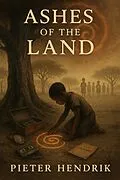Synopsis of the epic Ashes of the Land
Mr. Niemand buries not just names but also the voices, the actions, and the truth that the land carries with it. Kgositso's family's farm, Doornfontein, stands on land once claimed by people with erased identities and unrecognized family treasures. An etched spiral in the ground often leads to consequences written into the lives of different generations.
The first part of the book centers on an aged Gert dealing with what she did decades before. The old land title Gert brings home?altered to "Niemand" during the Nazi period?reveals that he shares the same last name as the family who was taken from this home. A clause had been added to the original deed, but it is now forgotten: Land cannot be taken if there is evidence of family heritage or burial on the property. With his wife Anna, their activist daughter Magda, and Zak, the son he is estranged from, Gert works to obtain proof supporting their convictions. There are old images, carved spirals, soiled artifacts, and the names of the vanished, whose remains remain buried beneath the orchard.
Because her ideas are so radical, the state investigates Magda for her teaching activities. After making a spiral-coded oral account, Gert places the recording with the Earth. At the same time, Zak returns to deal with what he has received. He has Anna's registry of missing children and uncovers that state records are hiding audits related to land. Such documents demonstrate that the process of expropriating Doornfontein was incomplete. But resistance has a cost: We learn that Koosie, Gert's brother and a tough law-enforcer, suppresses any attempts to speak out using damaging bureaucratic tricks and hidden documents.
When Anna is buried, Gert puts her Bible at the base of the baobab. Its true beginnings are lost in a history that cannot be found in books. A spiral dug into the soil filled with sorrow, honesty, and uncertainty. Children living nearby begin to outline the bird shape on paper, without realizing why. Mpho, a former farmhand and secret messenger, brings Anna the tape with her witness statement that she had once left behind the water tank.
As he studies the encrypted journal, he hears of Jonas, who died as a three-year-old and was buried with no funeral or grave, and discovers that Anna spreads spirals and the names of those she knew as if planting seeds. They eventually merge into one act, not by arguing in court, but by feeling the deep meaning of the land. The final part of Gert's memoir becomes a maize loaf that Zak takes across the border and gives to Clara van Dyk, a white journalist willing to speak out against these actions.
Clara uses Gert's voice through shortwave radio airwaves. The spiral represents the struggle, the process of fixing the past, and a gospel that isn't written. But paying this cost proves high?Gert dies soon after making his final recording, sharing his story of failure and love equally. Zak buries Gert's recording, the locket, and Anna's cloth in the orchard and calls it the "First Classroom," where the land replaces what law had destroyed.
In the concluding chapters, new generations become the central characters. Children walk along spirals and sing music with no words. One person dreams about Anna and can recognize her face, while another hears her whistle. Things we toss aside as junk can be turned into relics. The moment Zak and Mpho see the sealed, now forgotten well, carved with voices, they realize there is more to the archive than a ledger. The last cassette is secured by placing it into the ocean. Two tones rise?braided, unfinished.
Instead of ending on a note of resolution, Ashes of the Land picks up and moves forward. Zak blows Anna's cracked whistle. The children sing. The spiral remains. Far from being silent, memory tells us its story in ash, breath, and soil.
Autorentext
The author loves writing and has been telling stories for most of her life. Yet, he was more attracted to a story's telling than the story itself; he embarked on an industrial automation and teaching profession, leaving his literary aspirations on the shelf for over forty years. However, his love for fiction remained intact, thus forming a rather profound, accurate, and rich in life experience voice.
The fact that he started publishing late in his life only shows that he has always been passionate about telling stories. People always look forward to reading his stories since they contain adventure, self-discovery, and optimism in people. These stories are heart-touching, and their impact remains etched in the hearts and minds of people for years.
